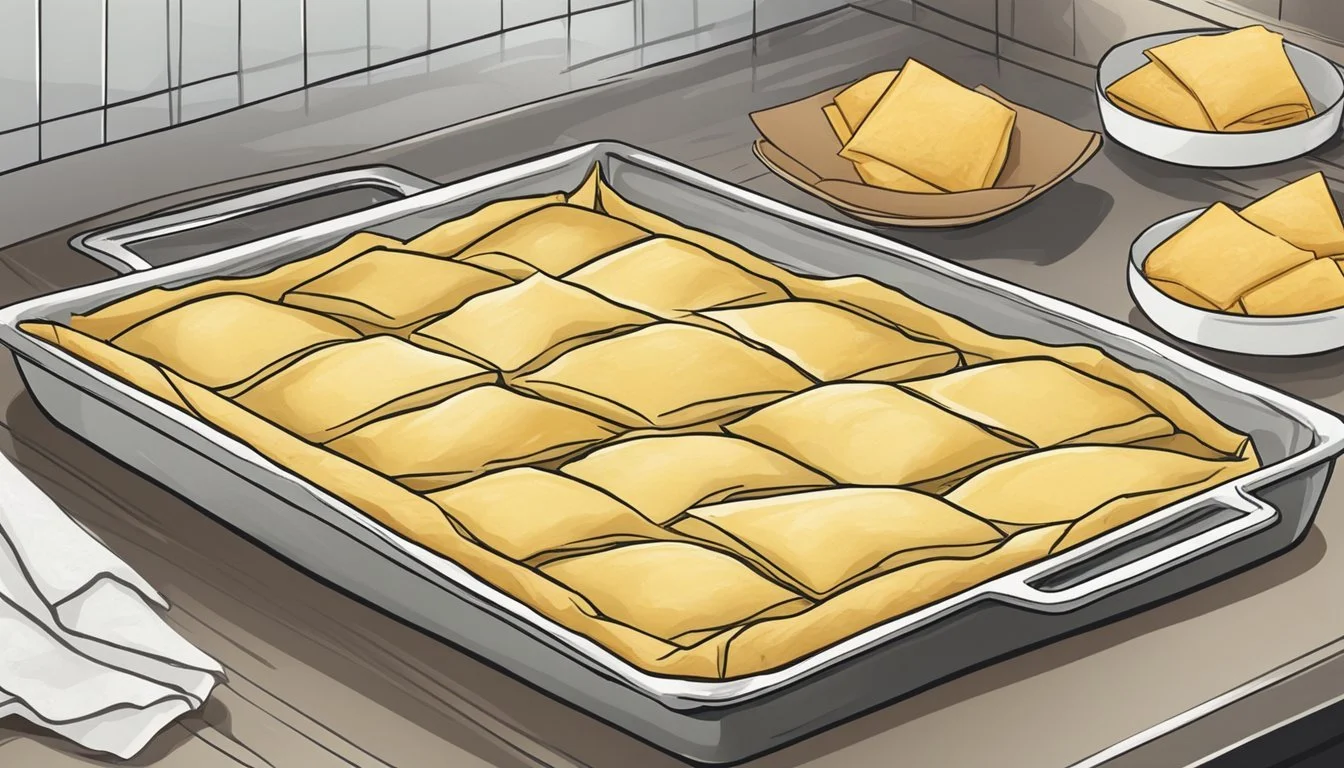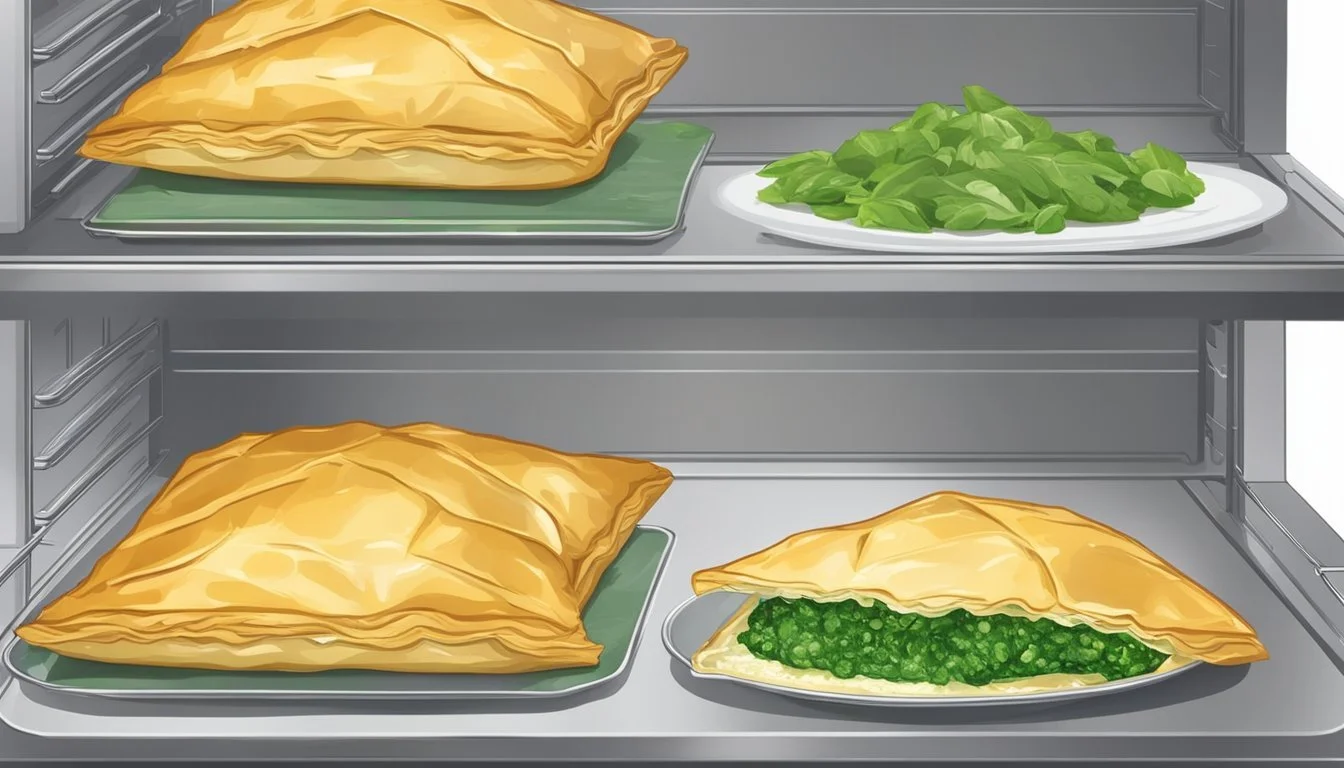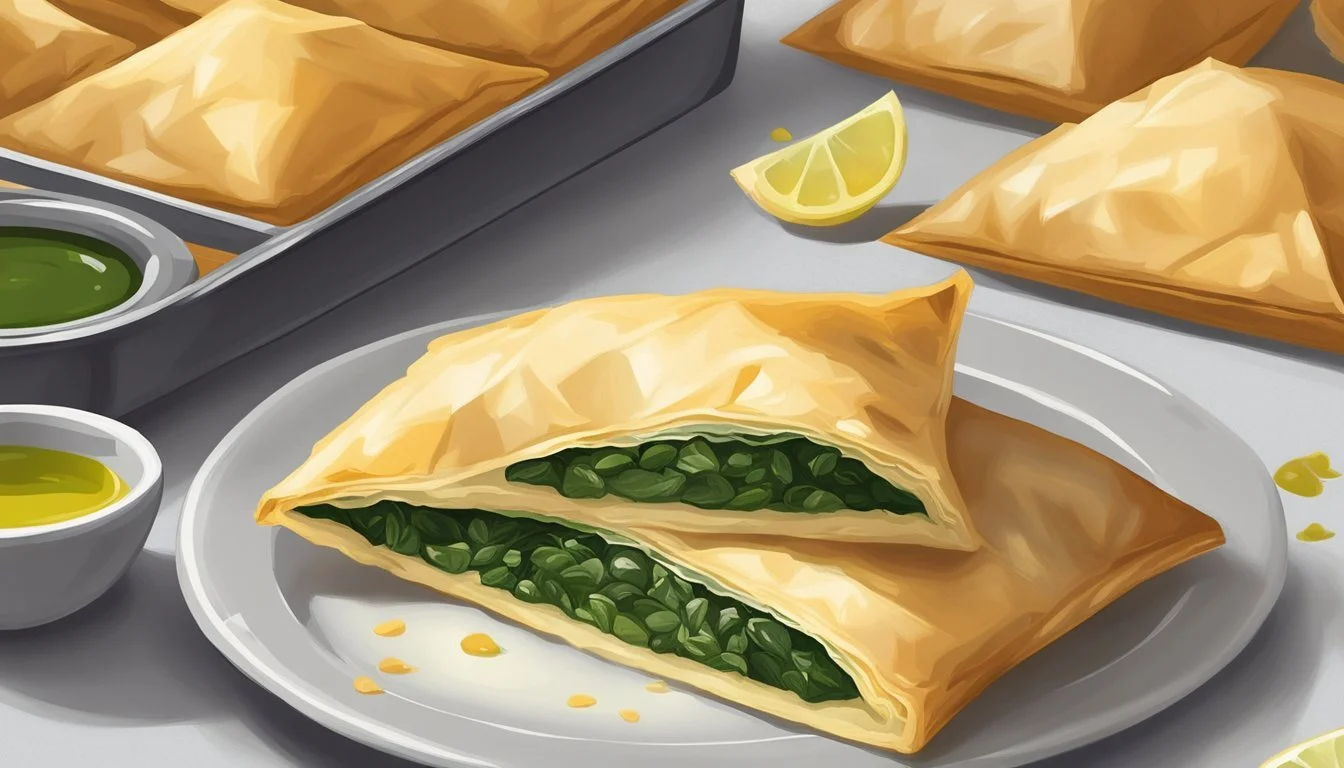Best Way to Reheat a SpanakopitaEnsuring
Introduction to Greek Spinach Pie
Greek Spinach Pie, also known as Spanakopita, is a traditional Greek dish made with spinach, feta cheese, and phyllo dough. This delicious pie is a staple in Greek cuisine and is often served as a main course or side dish. The combination of spinach, feta cheese, and phyllo dough creates a unique and flavorful taste experience. To make a great Greek Spinach Pie, it’s essential to use high-quality ingredients, such as fresh spinach, crumbled feta cheese, and phyllo pastry. With a prep time of about 30 minutes and a cook time of 40-50 minutes, this easy spanakopita recipe is perfect for a weeknight dinner or a special occasion.
Ensuring Your Phyllo Stays Crispy
Spanakopita, a traditional Greek dish with flaky phyllo pastryspinach, and feta cheese, is a flavorful and texturally satisfying experience. The challenge of reheating spanakopita lies in maintaining the delicate crispiness of its phyllo layers without drying out the filling. Achieving the ideal balance of a warm, gooey interior and a crispy exterior requires careful choice of reheating method.
They may use several reheating techniques to preserve the texture and flavor of spanakopita. An oven or an air fryer are often preferred for a uniformly crispy result, using moderate heat to gently warm the pastry through to the middle. Avoiding a microwave, which can lead to soggy pastry, is a common recommendation, as it doesn't provide the dry heat needed to keep the phyllo crisp. Instead, the convection of an oven or the rapid air circulation in an air fryer can reheat the spanakopita evenly without sacrificing its texture.
Instructions for reheating often suggest preheating the oven or air fryer to the right temperature before placing the spanakopita inside. They may line a baking sheet with parchment for an oven or place the pastry directly in the basket of an air fryer. Regular checks are recommended to prevent overcooking, ensuring that the spanakopita is heated through to just the right degree of crispness.
Understanding Spanakopita
Before diving into the aspects of reheating spanakopita, it's essential to understand what constitutes this beloved Greek dish and its traditional preparation methods. Known for its flaky phyllo pastry and savory filling, spanakopita has become a staple in Mediterranean meals.
Key Ingredients
The core components of spanakopita include:
Phyllo pastry: Thin unleavened dough known for its delicate and flaky texture.
Spinach: The primary leafy green that gives the dish its characteristic flavor and name.
Feta cheese: A crumbly and tangy Greek cheese that adds a creamy texture.
Egg: Acts as a binder for the filling, providing structure once baked.
Chopped onion and garlic: Essentials for the aromatic base of the filling.
Dill, salt, black pepper, and pepper: Commonly used herbs and seasonings that enhance the taste.
The combination of these ingredients results in a quintessential Mediterranean dish that delights with its blend of textures and flavors.
Traditional Preparation
Traditionally, spanakopita is prepared by:
Making the Filling: Sautéing onion and garlic until fragrant, then stirring in spinach until wilted and cooked. It is crucial to remove excess moisture from the cooked spinach to prevent sogginess; this can be done using a clean damp towel or a potato ricer. Off the heat, feta cheese, beaten egg, dill, salt, and pepper are added to the mixture.
Assembling: The phyllo dough is laid out flat, with individual sheets brushed with olive oil or melted butter. The spinach mixture is then placed onto the dough and folded or rolled.
Baking: The assembled spanakopita is baked until the phyllo pastry turns golden brown and achieves its famous crispness.
The result is a savory Greek spinach pie that can be enjoyed either as a main course or a hearty side dish.Preservation and Storage
Understanding Phyllo Dough
Phyllo dough is a crucial component of Greek Spinach Pie, and understanding how to work with it is essential for making a great pie. Phyllo dough is a type of pastry dough made from flour, water, and oil. It’s known for its thin, flaky layers, which create a crispy and golden brown texture when baked. To work with phyllo dough, it’s essential to thaw it according to the package instructions and keep it covered with a damp tea towel to prevent it from drying out. When assembling the pie, brush each phyllo sheet with melted butter to create a rich and flavorful crust.
Proper storage is essential to maintain the quality and extend the shelf life of spanakopita. Whether freshly baked or frozen, careful preservation ensures the phyllo pastry remains crisp when reheated.
Storing Freshly Baked Spanakopita
Once spanakopita has cooled to room temperature, leftover spanakopita should be transferred to a baking dish for storage. To retain crispness, layering the pieces with parchment paper can prevent them from becoming soggy. The airtight container can then be stored in the refrigerator for up to three days. Storing it beyond this period can affect its quality and taste.
Freezing and Thawing Procedures
To freeze spanakopita, one must wrap each piece individually in plastic wrap, then again with aluminum foil to protect against freezer burn. For better organization and preservation, place the wrapped pastries into a freezer-safe container or bag and ensure it's sealed tightly. Spanakopita can be stored in the freezer for up to three months. When it's time to reheat, thaw the frozen spanakopita in the refrigerator overnight. This gradual thawing helps preserve the texture and flavor of the phyllo dough.
Food Safety Guidelines
When handling and storing Greek Spinach Pie, it’s essential to follow proper food safety guidelines to prevent foodborne illness. Always handle the pie with clean hands, and make sure to store it in an airtight container in the refrigerator at a temperature of 40°F (4°C) or below. When reheating the pie, make sure it reaches an internal temperature of 165°F (74°C) to ensure food safety. It’s also essential to label and date the container, so you know how long it’s been stored.
Reheating Guidelines
Reheating spanakopita properly is crucial to maintain its crispy phyllo pastry and ensure it’s heated through. Improper reheating can make spanakopita soggy, especially if excess moisture from spinach is not managed. Each method provided below is designed to help achieve a crispy texture and great tasting results without drying out or overheating the delicious Greek delicacy.
Preparing for Reheat
Before reheating spanakopita, it is crucial to remove any excess liquid and excess water to ensure optimal texture and flavor. One should ensure it’s completely thawed if it was frozen. To prevent sogginess, removing any wrapping and setting the pastry on parchment paper is advised, as this allows for better heat distribution.
Reheating Temperature and Time
To reheat Greek Spinach Pie, preheat the oven to 350°F (180°C). Place the pie on a cookie sheet lined with parchment paper and bake for 15-20 minutes, or until it reaches an internal temperature of 165°F (74°C). You can also reheat the pie in the microwave, but be careful not to overheat it, as this can cause the phyllo dough to become soggy. When reheating, make sure to check the pie frequently to avoid overcooking. With these simple reheating instructions, you can enjoy your delicious Greek Spinach Pie for several days.
Oven Reheating Method
Preheat: Set the oven to 350°F (175°C) and ensure it is a preheated oven.
Setup: Place spanakopita on a baking sheet lined with parchment paper.
Reheat: Heat for 10-15 minutes in the preheated oven at 350 degrees. Check the internal temperature with a food thermometer to reach a safe and enjoyable level.
Stovetop Reheating Method
Preheat: Warm a non-stick skillet over medium heat and add a small amount of butter or olive oil.
Reheat: Place the spanakopita in the skillet and cover. Heat each side for a couple of minutes until the pastry regains its crispiness.
Air Fryer Reheating Method
Preheat: Set the air fryer to 375°F (190°C).
Place: Arrange the spanakopita in the basket without overlapping.
Reheat: Cook for 5-7 minutes. Open and check periodically to ensure even reheating.
Microwave Reheating Method
Setup: Place spanakopita on a microwave-safe dish, covering lightly with a damp paper towel.
Reheat: Use high setting in 30-second intervals, checking between to gauge warmth. Note: This method may not retain the crispiness of the pastry as effectively as others.
Serving Recommendations
Reheating spanakopita properly ensures it retains its signature crispy texture, and pairing it with the right side dishes and sauces can elevate the overall dining experience. The right accompaniments should enhance the flavors of the spanakopita without overpowering it.
Complementary Side Dishes
The ideal side dishes for spanakopita should offer a refreshing contrast to its rich flavors. A Greek salad is a classic choice; the crispness of the vegetables and the tang of the feta cheese complement the savory pastry well. Here are two highly recommended side dishes:
Greek Salad: A mix of cucumbers, tomatoes, Kalamata olives, red onions, fresh parsley, and feta cheese drizzled with a zesty Greek dressing.
Roasted Vegetables: Seasonal vegetables such as zucchini, bell peppers, and red onions, roasted until tender, provide a healthy and colorful side option.
Sauce Pairings
The right sauce can serve as a perfect dip or drizzle for spanakopita. Tzatziki sauce, with its cool and creamy texture, pairs excellently with the warm, crispy phyllo. For those serving spanakopita as an appetizer, consider these sauce pairings:
Tzatziki Sauce: A blend of Greek yogurt, grated cucumber, garlic, lemon juice, and dill.
Lemon Garlic Yogurt Sauce: A simpler sauce that combines Greek yogurt with lemon juice and a hint of garlic.
It's ideal to serve spanakopita immediately after reheating to enjoy its best texture and to complement it with these light and refreshing sides and sauces for a well-rounded experience.
Advanced Tips and Tricks
When reheating spanakopita, the ultimate goal is to maintain that delightful crispy texture of the phyllo dough. Achieving this requires careful attention to both the reheating method and the small details that can make a big difference.
Enhancing Crispiness
To enhance the crispiness of spanakopita during reheating:
Butter or Olive Oil: Lightly brush the phyllo, especially the top layer, with either melted butter or olive oil before reheating. This not only contributes to the flavor but also helps in achieving a more golden, crispy exterior.
Utilizing the Oven: Reheat in the oven at a moderate temperature, around 350°F (175°C), to ensure even heating and crispiness. Place the spanakopita on a wire rack over a baking sheet to allow air to circulate around the pastry.
Avoiding Common Reheating Mistakes
Common mistakes can lead to soggy or unevenly heated spanakopita. Here's how to avoid them:
Prevent Moisture: Covering spanakopita with a wet paper towel in the microwave can dampen the phyllo. Instead, use a microwave-safe lid that allows steam to escape, heating in short bursts of 30 seconds to prevent sogginess.
Avoid Overcrowding: Whether using an oven, air fryer, or stovetop, do not overcrowd the pastries. Ensure they are spaced out to allow for heat distribution and avoid steaming.
Monitor Heat: Phyllo can go from perfectly crispy to burnt quickly. Keep a vigilant eye, especially when using the air fryer or stovetop, checking frequently to ensure optimal results.
Variations of Spanakopita
Spanakopita, a beloved Greek pastry, comes in various forms that can influence both flavor and presentation, with ingredients like fresh or frozen spinach and crumbled feta cheese playing pivotal roles in its creation.
Spinach and Cheese Variations
Traditional homemade spanakopita often calls for fresh spinach for its bright, earthy taste. However, one can also opt for frozen spinach as a convenient and still flavorful alternative. The choice of cheese is crucial, with crumbled feta cheese being a classic choice due to its creamy and tangy profile. Some variations of the traditional spanakopita recipe may include a blend of cheeses, such as ricotta or myzithra, to add depth and richness. Additionally, incorporating dill weed and scallions can enhance the overall flavor, offering a fresh and aromatic twist to the dish.
Fresh Spinach: Brings a more vibrant color and slightly textured consistency.
Frozen Spinach: Offers convenience without compromising too much on taste; must be thoroughly drained.
Crumbled Feta Cheese: Adds the essential tangy flavor to the dish.
Other Cheeses: Ricotta for creaminess; myzithra for a salty, nuanced twist.
Dill Weed: Adds a unique, aromatic flavor that complements the spinach and cheese.
Scallions: Provide a mild onion-like taste, enhancing the overall flavor profile.
Spanakopita Triangles
Spanakopita triangles are a popular variation that serve as perfect appetizers or finger foods. This version embraces the same fundamental spanakopita recipe but is crafted in smaller, individual portions. Whether one is preparing the homemade spanakopita from scratch or utilizing store-bought phyllo, ensuring that the pastry remains crisp is key to a satisfying texture.
Size: Smaller than traditional cuts, ideal for single servings.
Preparation: Can be made ahead of time and frozen, requiring careful reheating to maintain crispiness. When cutting the phyllo dough into even sections or triangles, use a sharp knife to ensure clean cuts and properly separated layers.
By focusing on the quality of the ingredients and correct preparation techniques, these variations of spanakopita can showcase the versatility of this classic dish while maintaining its distinctive character.
Final Considerations
Before delving into specifics, it is crucial to note that reheating spanakopita can affect its nutritional profile and also pose potential dietary concerns, especially when it comes to ensuring the crispness and freshness of the phyllo pastry.
Health and Dietary Notes
Allergens: Spanakopita typically contains eggs, wheat (in the phyllo), and sometimes dairy. Those with allergies should reheat with care to avoid cross-contamination.
Nutritional Changes: Reheating leftovers can sometimes alter the dish's nutritional value. However, the method of reheating does not significantly change the levels of salt and pepper used in the original recipe.
Leftovers: When storing leftovers, seal them properly to maintain freshness and prevent the growth of bacteria. Leftovers should be consumed within 48 hours of initial cooking for best quality and safety.
Frequently Asked Questions
Can I add ingredients when reheating? It's best to reheat spanakopita as is. Adding ingredients like onions or extra spices may create moisture and make the pastry soggy.
My spanakopita isn't crispy after reheating; what can I do? If the phyllo isn't crispy, a few additional minutes in the oven at a lower temperature can help recrisp the pastry without burning it.
Is it safe to reheat spanakopita multiple times? For safety and quality, it is recommended to reheat only the portion you plan to eat. Continuously reheating can degrade the texture and taste.








